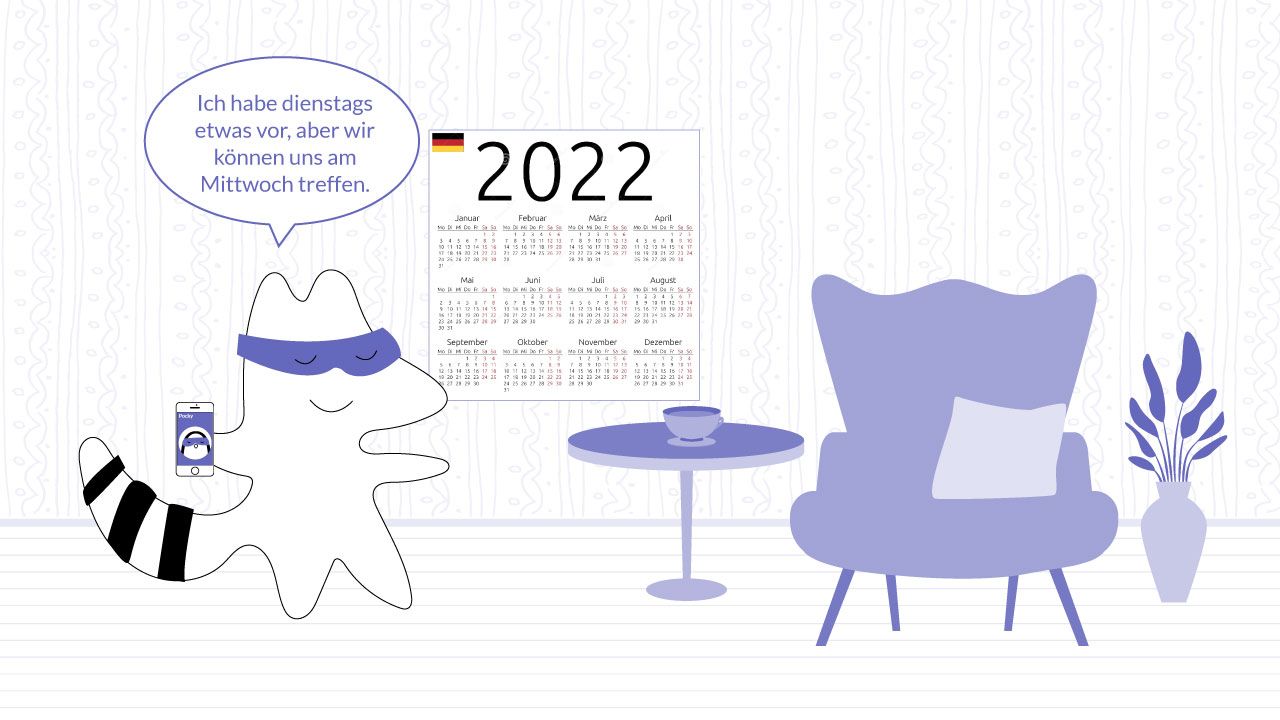
Learning how to read, write, and say dates in a foreign language is one of the first skills you should acquire when starting your language learning journey. Whether you’re traveling somewhere, making appointments, or planning something, it’s important to be able to correctly state different calendar terms. You’ll need to bear in mind that in different countries, date formats are written in different ways.
Today, let’s talk about the German date format, as well as the necessary vocabulary you need to know when talking about dates in German. Read on and make sure you know on which day the week starts in Germany, how months are called in the German language, and which date format to use when.
Months in German
Let’s start with the basics of the German calendar: here are the 12 months of the year in German with audio. Listen and repeat:
Native
Translation
Januar
January
Februar
February
März
March
April
April
Mai
May
Juni
June
Juli
July
August
August
September
September
Oktober
October
November
November
Dezember
December
All months in German have a masculine gender, but they most often appear without an article in sentences. Just like in English, they can be abbreviated by the first letters of their name: for example, Dez., Jan., Feb.
Moreover: all months, seasons, and days of the week in German start with capital letters, since all of them are nouns.
Seasons in German
While the months’ names in German are pretty similar to those in English, the names of the seasons can be a bit more difficult for English speakers learning German. Don’t worry, though: there are only four of them, two of which you already know, and just like months, they are all masculine.
Please note that, unlike months, you will most often use an article with the names of seasons when talking about them in general (i.e. “My favorite season is summer.)
Native
Translation
der Frühling
spring
der Sommer
summer
der Herbst
autumn
der Winter
winter

Apart from these names, you can also hear the word das Frühjahr when referring to spring. Das Frühjahr and der Frühling often appear as synonyms, and most people don’t pay much attention to the difference between them.
Nevertheless, it might be helpful for you to know that der Frühling refers to spring as the season, das Frühjahr has a meaning that’s closer to “early in the year,” referring to the beginning months of the year.
Months and Seasons with Prepositions
Most languages need you to use both months and seasons in a sentence, you need to put a correct preposition before them. In German, it’s the preposition im (a contraction of im+dem, which is der in the dative case) – we use it to say that something happened during the season or month.
Native
Translation
Ich wurde im Sommer geboren.
I was born in summer.
Zu meinem Geburtstag im Juli fahren wir nach Georgien.
For my birthday in July we're going to Georgia.
Days of the Week in German
Another helpful vocabulary you need to know when writing dates in German are the days of the week. Here they are – already with their common abbreviations.
| German | Abbreviation | English |
|---|---|---|
| Montag | Mo | Monday |
| Dienstag | Di | Tuesday |
| Mittwoch | Mi | Wednesday |
| Donnerstag | Do | Thursday |
| Freitag | Fr | Friday |
| Samstag | Sa | Saturday |
| Sonntag | So | Sunday |
As you can see, the German week starts on Monday instead of Sunday, and most days (with two exceptions) end with -tag, which is the German word for “day.” Just like months and seasons, days of the week are masculine in German.
The Issue of Case and Additional Vocabulary
To say that something happened on a certain day of the week, use the preposition am – a contraction of an and dem, the dative form of der.
The same contraction occurs when we talk about months or seasons in German. This happens because for most date expressions, we put the month/season/day in the dative case. For example:
Native
Translation
Ich habe seinen Brief am Dienstag erhalten.
I got his letter on Tuesday.
Nevertheless, there are some other date expressions where the day of the week is put in the accusative case and/or used without a preposition. Add these to your vocabulary – feel free to change the word “Monday” to any other day of the week.
Native
Translation
montags
(on) Mondays
jeden Montag
every Monday
letzten Montag
last Monday
übernächsten Montag
the Monday after the next
jeden zweiten Montag
every other Monday
Welchen Tag haben wir heute?
What day is today?
Heute ist Montag.
Today is Monday.

Date Formats in German
Finally, let’s tackle the topic of German dates. Don’t worry, it’s pretty simple now that we know all the basics.
The main thing you should be aware of is that Germans write their dates in the order of the day, the month, and then the year. Just like English dates, German dates require the use of ordinal numbers.
When writing the date in German, there are two ways to do so:
1. If you want to write out the month in German letters, use the preposition am + number followed by a full stop + month + year.
Here, the full stop serves as the ordinal ending -ten (in English, you’ll see -th, -rd, or -nd following a number). For example:
Native
Translation
Am 14. Juli.
On July 14th.
Am 3. Oktober feiern die Deutschen den Tag der Deutschen Einheit.
On the 3rd of October, Germans celebrate Day of German Unity.
2. If you’re writing the date in the numbered format, use the same order of the day, month, year, divided by full stops. Germans don't use slashes, commas, or anything other punctuation marks. For example:
Native
Translation
Am 14.07.22/ [On 4/07
On 4/07/22
When saying the date in German, follow the same date order, but pronounce the ordinal number:
Native
Translation
Am vierzehnten Juli.
On July fourteenth.
Der einunddreißigste Dezember.
The thirty-first of December.

Ordinal Numbers in German
In order to make sure that you pronounce the dates in German correctly, here’s a quick recap of the German ordinal numbers.
Most ordinal numbers in German end with -te (in the accusative case) or -ten (in the dative case). Starting with 20, the ending becomes -ste or -sten, respectively.
Nevertheless, just like in English, there are three irregular formations of ordinal numbers in German:
| 1st | der erste | |
| 2nd | der zweite | |
| 3rd | der dritte | |
| 4th | der vierte | |
| 5th | der fünfte | |
| 11th | der elfte | |
| 20th | der zwanzigste | |
| 21st | der einundzwanzigste |
Conclusion

Learning how to write dates in German can be a challenge, but with practice, you'll get it down. Just remember that Germans write the date in day-month-year order, and use full stops in written speech. As long as you keep these basics in mind, expressing dates correctly in the German language should be a piece of cake.
And if you want to boost your skills and learn German vocabulary relating to other topics, such as time or business, make sure to check out other posts on our blog. Want to start practicing right away? Then download the Langster app and learn German with daily short stories and news.









